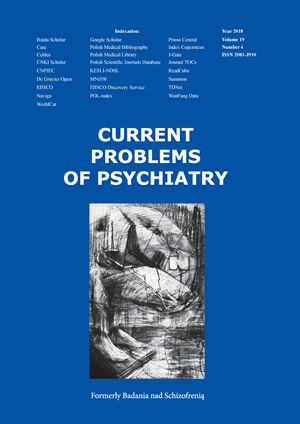Jacob Levy Moreno’s psychodrama as a work technique for treating patients in group and individual psychotherapy
DOI:
https://doi.org/10.2478/cpp-2018-0019Keywords:
psychotherapy, psychodrama, monodramaAbstract
Introduction. The basic purpose of this article is to present Jacob Levy Moreno's psychodrama method as the psychotherapeutic technique useful in work with patients during individual and group psychotherapy.
Material and Method: The author presents the analysis of case studies of patients treated in individual and group psychotherapy. He instances the examples of psychodramatic work on the stage as well as monodramatic and reports their importance in the process of patient psychotherapy. He discusses the effects of these act ivities in the context of changes in the emotional and interpersonal functioning of patients.
Results: The given examples of monodrama and psychodramatic works illustrate the mechanisms of the changes offered by the method, e.g. insight, abreaction, acceptance of internal impulses, confrontation with the feelings of other people, training of alternative behaviors. In the article one can follow each subsequent step of analyzing intrapsychic conflicts of patients, which, thanks to the play on the stage, can be named and experienced by them.
Conclusions: Psychodrama, used in the psychotherapeutic work of the group and in individual work with the patient (in the form of a monodrama), gives great opportunities to broaden the insight of the patient into very complicated internal mechanisms of conflicts and deficits. Psychotherapist - leader encourages patients to be creative and to spontaneous development of their blocked personality elements. The specificity of psychodrama is a relatively quick resolution of many years of ongoing conflict and permanent reparation of traumatic experiences, even from early childhood.
References
1. Roine E. Psychodrama. O tym, jak grać główną rolę w swoim życiu. Opole; Wydawnictwo "KONTAKT": 1994; 22.
2. Moreno J.L. Who schall survive? New York; Beacon House: 1978; 25.
3. Galińska E. Inne techniki psychoterapii – Psychodrama. W: Grzesiuk L.: Psychoterapia – teoria. Warszawa; Eneteia: 2005; 517-530.
4. Aleksandrowicz J. Psychoterapia. Kraków; Wydawnictwo Uniwersytetu Jagiellońskiego: 2004.
5. Kennard D., Roberts J., Winter D. Interwencje psychoterapii grupowo-analitycznej. Oficyna Ingedium: 2013.
6. Pawlik J. Psychodrama i techniki niewerbalne. Warszawa; Eneteia: 2012
7. Bielańska A. Teatr, który leczy. Kraków; Wydawnictwo Uniwersytetu Jagiellońskiego: 2000.
8. Florek M. Złość – wróg czy sojusznik w rozwoju ról na drodze ku spontaniczności i kreatywności. Wykorzystanie Psychodramy w pracy ze złością w psychoterapii. Nie publikowana praca końcowa szkolenia II stopnia Psychodramy. Kraków; Polski Instytut Psychodramy: 2011.
9. Bielańska A. Psychodrama – elementy teorii i praktyki. Warszawa; Eneteia: 2009;145.
10. Litwińska-Rączka K. Analiza procesu terapeutycznego pacjenta. Proces psychoterapii indywidualnej. Nie publikowana praca przygotowana na egzamin certyfikacyjny Sekcji Naukowej Psychoterapii Polskiego Towarzystwa Psychiatrycznego. Kraków; 2014.
11. Johnson S. Humanizowanie narcystycznego stylu. Warszawa; Jacek Santorski & CO Agencja Wydawnicza: 1993.
12. Symington N. Narcyzm – nowa teoria. Gdańsk; Wydawnictwo Imago: 2013.
13. Yalom I. Psychoterapia grupowa – teoria i praktyka. Kraków; Wydawnictwo Uniwersytetu Jagiellońskiego: 2006.
Downloads
Published
Issue
Section
License
Copyright (c) 2018 Author

This work is licensed under a Creative Commons Attribution-NonCommercial-NoDerivatives 3.0 Unported License.


